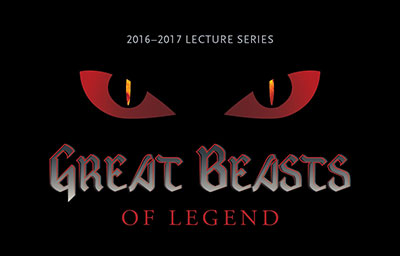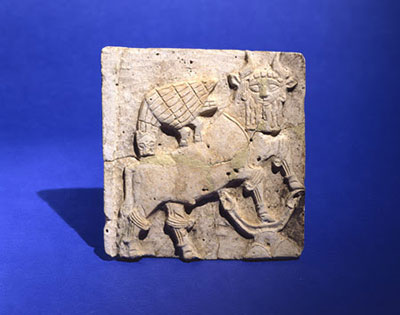Great Beasts of Legend
Penn Museum's 2016-17 Lecture Series
Begins Wednesday, October 5

Philadelphia, PA, Fall 2016—From centaurs to sphinxes to constellations in the stars, a fascinating array of strange and powerful creatures—some mythical, some real—have been recognized by human civilizations throughout our history. These ancient beasts come to light in the Penn Museum’s new Great Beasts of Legend evening lecture series, featuring prominent scholars from the Penn Museum and the University of Pennsylvania. The series opens Wednesday, October 5 at 6:00 pm, and continues the first Wednesday of each month through June 2017.
Guests can sign up for a series subscription and save: $40, general public; $15, Penn Museum members. Individual lectures with advance registration are $5, general public; $2, Museum members; and $10 at the door based on availability. For more information, call 215.898.2680. To register, visit penn.museum/greatbeasts.
Now in its ninth “Great” season, past themes of these popular, wide-ranging illustrated talks have included Great Voyages and Great Myths and Legends. This season’s Great Beasts of Legend theme examines iconic monsters of the ancient world through historical, anthropological, and archaeological contexts. Speakers explore the symbolism, mythic narratives, and scholarly debates surrounding these supernatural beings associated with the Maya and Native American cosmos, Mesopotamia, and ancient Greece and Egypt.
The Penn Museum stays open first Wednesdays until 8:00 pm, and lecture guests are welcome to visit the galleries before and after the talks.

Wednesday, October 5, 6:00 pm
Dr. Steve Tinney, Associate Curator, Babylonian Section
Anzu: The Lion-Headed Eagle Who Wanted to Rule the Universe
Anzu is one of ancient Mesopotamia’s iconic monsters, a giant eagle with a lion’s head, depicted in art from as early as 2500 BCE. As a symbol of the gods and friend of heroes, Anzu's early career seems benign, but somewhere along the way his ambition gets the better of him. Dr. Tinney follows Anzu from artistic masterpiece to cosmic threat to his eventual ignominious demise by a fatal twist.
Wednesday, November 2, 6:00 pm
Dr. Jeremy McInerney, Davidson Kennedy Professor, Department of Classical Studies, University of Pennsylvania
Centaurs, Sirens, and Chimaera: The Greeks and their Monsters
The Greek imagination was populated with all sorts of hybrids and monsters, from the half-horse, half-man centaur to the chimaera, a blend of lion, snake and goat. What function did these creatures play in Greek culture? This talk explores some of the most extraordinary monsters and fabulous creatures of the Greeks and try to explain where they came from and why the Greeks were fascinated by them.
Wednesday, December 7, 6:00 pm
Dr. Jennifer Houser Wegner, Associate Curator, Egyptian Section, Penn Museum
The Strong, Silent Type: The Sphinx
Egyptian religious imagery gives us an awesome assortment of fantastic hybrid beings and deities that are half human, half animal, or a composite of numerous creatures. Perhaps none of these beings are as evocative as the sphinx. Usually depicted as a human-headed lion, the sphinx was a protective entity and sphinx imagery appeared in Egyptian art, architecture and texts for thousands of years. In this lecture, Dr. Wegner examines the varied roles of the sphinx in ancient Egypt.
Wednesday, January 4, 6:00 pm
Dr. Janet Monge, Associate Curator, Physical Anthropology Section, Penn Museum
The Hobbits of Flores Island: Myth, Magic, Majesty of Homo floresiensis
Standing at three and a half feet tall and about 75 pounds, Homo floresiensis is the smallest adult skeletal specimen in the whole of human evolutionary history. Found in 2003, the “hobbit” or “halfling” was so named because of its diminutive size. Some have claimed that the hobbit is a pathological specimen, showing features of microcephaly, Down syndrome, or dwarfism, while others consider it to be a new species within the human lineage, eventually becoming extinct when modern humans arrived on the island. There seems to be no end in sight on the debates that surround this hot-button issue in human evolution.
Wednesday, February 1, 6:00 pm
Dr. Simon Martin, Associate Curator and Keeper of Collections, American Section, Penn Museum
Monsters of the Maya Cosmos
The Maya universe was populated by a variety of strange beasts and hybrid entities, some as actors in mythic narratives, others as symbolic representations of the sky, earth, and netherworld. However bizarre and complex their form, each had a coherent part to play in a wider religious system. One of the more energetic areas in Maya studies today is the effort to fathom their meanings and, by doing so, enter the imagination and consciousness of an ancient American people.
Wednesday, March 1, 6:00 pm
Dr. Megan Kassabaum, Weingarten Assistant Curator, American Section, Penn Museum
Underwater Panthers and Their Place in the Native American Cosmos
Archaeologists generally agree that certain beliefs about the cosmos are broadly shared among indigenous peoples of the Americas. Though the details vary wildly, the world is generally seen as consisting of three layers—the Above World, the Middle World, and the Beneath World. While humans live their everyday lives in the Middle World, the Above and Beneath Worlds are inhabited by a variety of supernatural beings. One of the most intriguing characters to inhabit the Beneath World is the underwater panther, a composite creature with both feline and serpentine characteristics that is associated with the dangerous yet beneficial powers of rivers, waterfalls, whirlpools and caves.
Wednesday, April 5, 6:00 pm
Dr. Patrick Glauthier, Department of Classical Studies, University of Pennsylvania
The Beasts in the Stars
Aries the Ram, Taurus the Bull, Cetus the Sea-monster—there's no shortage of mythical animals among the constellations of ancient Greece and Rome. But why do such creatures populate the heavens in the first place? And what did they mean to the societies that first identified and named them? Although it can be hard for us to clearly identify two Bears circling up above, the ancient imagination saw animalistic drama and intrigue all over the night sky, and the particulars of these narratives were often felt to impact life on earth. In this talk. Dr. Glauthier explores the history of some of these constellations, their representations in ancient art and literature, and their role in ancient Greco-Roman society more broadly.
Wednesday, May 3, 6:00 pm
Dr. Deven Patel, Assistant Professor, Department of South Asia Studies, University of Pennsylvania
Man-Lions, “Blood-seed” Demons, and Wish-Fulfilling Cows: Assorted Beings from the Indian Imagination
The Beast in early South Asia runs the gamut of imaginative possibilities. Visualized in mythological literature and the plastic arts, unique and yet oddly recognizable Beings bubbled up for centuries from the psychic depths of Indian peoples. In this talk. Dr. Patel highlights some of the great Beasts of these lands: menacing demons, divine emanations both majestic and hideous, sublime animals that defy all expectations, and hybrid human/animal forms shuttling between mortal and immortal worlds.
Wednesday, June 6, 6:00 pm
Dr. Adam Smith, Assistant Curator, Asian Section, Penn Museum
Tomb Guardians: The Story of the Chinese Winged Lions in the Penn Museum
Dr. Smith discusses the earliest examples of monumental stone sculpture from East Asia in the Penn Museum, the two Winged Lions that confront one another across the space of the Chinese Rotunda. These examples are unmistakably Chinese in style, but by the time they were made, Winged Lions had long been in use across Eurasia as far as the Mediterranean as components of monumental architecture. The process by which Winged Felines reached China is complex and not fully understood, but their arrival is unmistakably part of a package of innovations that included rock-cut and masonry architecture, fluted stone columns, the first translations into Chinese of Buddhist literature, and the first Chinese representations of the Buddha.
About the Penn Museum
The Penn Museum (the University of Pennsylvania Museum of Archaeology and Anthropology) is dedicated to the study and understanding of human history and diversity. Founded in 1887, the Museum has sent more than 300 archaeological and anthropological expeditions to all the inhabited continents of the world. With an active exhibition schedule and educational programming for children and adults, the Museum offers the public an opportunity to share in the ongoing discovery of humankind's collective heritage.
The Penn Museum is located at 3260 South Street, Philadelphia, PA 19104 (on Penn's campus, across from Franklin Field). Public transportation to the Museum is available via SEPTA's Regional Rail Line at University City Station; the Market-Frankford Subway Line at 34th Street Station; trolley routes 11, 13, 34, and 36; and bus routes 21, 30, 40, and 42. Museum hours are Tuesday through Sunday, 10:00 am to 5:00 pm, with extended hours the first Wednesday of each month (to 8:00 pm). Closed Mondays and holidays. Regular Museum admission donation is $15 for adults; $13 for senior citizens (65 and above); free for U.S. Military; $10 for children and full-time students with ID; free to Members, PennCard holders, and children 5 and younger. Hot and cold meals and light refreshments are offered to visitors with or without Museum admission in The Pepper Mill Café; the Museum Shop offers a wide selection of gifts, books, games, clothing and jewelry. The Penn Museum can be found on the web at www.penn.museum. For general information call 215.898.4000.
Photo: Anzu (shown at left), one of ancient Mesopotamia’s iconic monsters, was a giant eagle with a lion’s head, depicted in art from as early as 2500 BCE. On Wednesday,October 5, Dr. Steve Tinney, Associate Curator, Babylonian Section, kicks off the Penn Museum’s Great Beasts of Legend lecture series with an in-depth look at Anzu, following the creature from artistic masterpiece to cosmic threat to his eventual demise by a fatal twist. Photo: Penn Museum.
###
About the Penn Museum
The Penn Museum’s mission is to be a center for inquiry and the ongoing exploration of humanity for our University of Pennsylvania, regional, national, and global communities, following ethical standards and practices.
Through conducting research, stewarding collections, creating learning opportunities, sharing stories, and creating experiences that expand access to archaeology and anthropology, the Museum builds empathy and connections across diverse cultures
The Penn Museum is open Tuesday-Sunday, 10:00 am-5:00 pm. It is open until 8:00 pm on first Wednesdays of the month. The Café is open Tuesday-Thursday, 9:00 am-3:00 pm and Friday and Saturday, 10:00 am-3:00 pm. On Sundays, the Café is open 10:30 am-2:30 pm. For information, visit penn.museum, call 215.898.4000, or follow @PennMuseum on social media.



